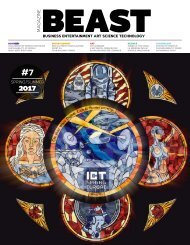Magazine BEAST #12 2018
Create successful ePaper yourself
Turn your PDF publications into a flip-book with our unique Google optimized e-Paper software.
#Science | Space<br />
69<br />
for professional and government users. Another service to<br />
be provided is Authentication: it will allow users to make sure<br />
that the signals they are using in their solutions do come from<br />
legitimate sources (the GNSS satellites). Our constellation will<br />
also support efforts to improve the coverage of satellite-based<br />
Search And Rescue (SAR) services that allow to better localize<br />
users in distress situations. Finally, there will be additional services<br />
that will allow users to have even higher precision via the third<br />
frequency,» explains Omar Valdés, who’s currently responsible<br />
for fostering the adoption of the European GNSS in the Space<br />
and IoT market segments.<br />
«Incorporating Galileo is the hot topic in the GNSS world»<br />
For years, the main challenge for the adoption of Galileo was the<br />
incompleteness of the constellation. After the Initial Services<br />
declaration in December 2016, the situation changed dramatically:<br />
there has been an explosion of chipsets (the electronic circuits<br />
that «listen» to GNSS satellites and provide the device with<br />
the PNT – Position, Navigation & Timing), receivers, and fully<br />
integrated devices that support Galileo. Proof of the success of<br />
the European GNSS, Galileo, is that it is increasingly supported in<br />
mobile devices. It first started in July 2016 with the BQ Aquaris<br />
x5, with a Qualcomm Snapdragon 652 chip, which was the<br />
first Galileo-enabled phone ever released. Since then, leading<br />
brands Apple, Huawei and Samsung have joined the movement<br />
and are currently using the European geolocation system in<br />
their latest smartphones. «It seems that incorporating Galileo is<br />
now the hot topic in the GNSS world!» highlights Omar Valdés.<br />
The next steps are the completion of the constellation to bring<br />
it towards its full-operational capability configuration. For this<br />
purpose, the European Union has been launching the necessary<br />
satellites: the latest four took off from the Europe’s Space Port<br />
in Kourou, in French Guyana, on the 25th of July. Once all of<br />
the recently launched satellites will be commissioned for service,<br />
the constellation will have 24 operational satellites. As M. Valdés<br />
puts it, «a key principle in GNSS is that the more satellites a<br />
receiver uses for computing the PNT solution, the better.<br />
Therefore, on top of the enhancement of services discussed<br />
previously, the interoperability of Galileo with the other GNSS<br />
allows the devices configured to use it to increase dramatically<br />
the amount of satellites they use improving in this way the PNT<br />
solution provided to their users».<br />
Facilitating the development of smart cities and autonomous<br />
mobility<br />
EGNSS (the European GNSS: Galileo and also EGNOS – European<br />
Geostationary Navigation Overlay Service) technologies and<br />
location-based services are now becoming ubiquitous in urban<br />
areas. All mass market electronic devices, from smartphones<br />
and wearable devices, such as fitness monitors, to traffic<br />
lights and other components of the expanding Internet of<br />
Things, now have the capability to broadcast their location.<br />
IoT is actually categorized into four building blocks: sensing,<br />
processing, connectivity and finally actuation. When it comes<br />
to outdoors location, the first one can notably be provided by<br />
a GNSS receiver acting as an enabler. IoT wouldn’t be possible<br />
without sensors, and is deeply interlinked with new concepts<br />
where location is essential: smart factories, big data processing,<br />
tracking objects and people, drones, but also smart cities and<br />
autonomous vehicles.<br />
Therefore, GNSS is key for IoT applications that require location<br />
outdoors: it is a reliable, cheap, and precise means to know where<br />
an object, “a thing,” is while outdoors. It acts as an enabler for<br />
IoT applications that require tracking, location, or navigation by<br />
providing a cost-effective, high-precision solution for PNT that<br />
can then be used to generate data that can be exploited by<br />
the devices themselves or in other devices remotely.<br />
This enables the provision of a new generation of locationbased<br />
smart services for citizens and corporations that includes<br />
health and well-being monitoring and security applications and<br />
the control and optimization of energy systems. He adds: «IoT<br />
is very interesting, especially when it comes to smart cities<br />
and tracking of goods and persons: tracking children or senior<br />
citizens that might get lost or need support is recognized as<br />
an important need as well as the tracking of dangerous goods<br />
that go through the streets of towns and cities. Making it short:<br />
Galileo applications are all around us and the system is now<br />
available to support them».<br />
Finally, mobility also benefits from Galileo as it uses the PVT<br />
information not only to find its way but also to report to its<br />
owner where it is at any time. As a matter of fact, mobility has<br />
taken a growing and important part of everyone’s daily lives.<br />
EGNSS aims at making life on the road easier by significantly<br />
reducing congestion and, consequently, reducing greenhouse<br />
gas emissions such as CO2. EGNOS and Galileo are helping urban<br />
authorities to improve the efficiency of road transportation<br />
through navigation, fleet management opportunities and<br />
satellite road traffic monitoring. Moreover, it is also bound to<br />
allow the development of autonomous mobility as geolocation is<br />
a key component of such self-driving systems, along with other<br />
sensor like inertial navigation systems (INS), odometers, radar,<br />
cameras, gyroscopes and others. GNSS plays a key role in most<br />
connected car applications, ultimately leading to autonomous<br />
mobility: «[Autonomous driving] is an excellent example of an<br />
application in which a device, in this case the vehicle, uses the<br />
PVT information not only to find its way but also to report to its<br />
owner where it is at any time,” adds Omar Valdés. Some other<br />
of those applications being integration with home networks,<br />
data exchange with insurers, manufacturers and third parties,<br />
improved navigation and positioning, payment integration,<br />
police warnings and location, and many more. Autonomous<br />
driving is the final step of a long automation process, as selfdriving<br />
vehicles are capable of sensing their environment and<br />
navigating without human input. Yet, autonomous cars exist<br />
today mainly as prototypes and demonstration systems.<br />
<strong>BEAST</strong> MAGAZINE <strong>#12</strong>

















